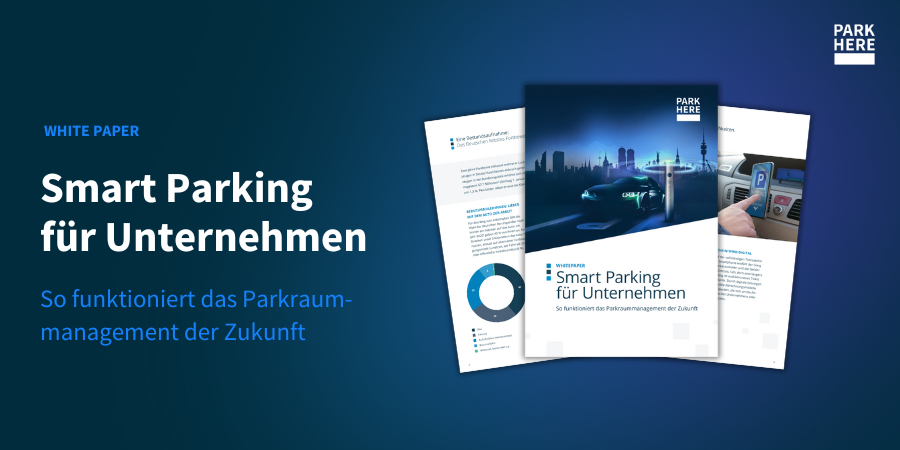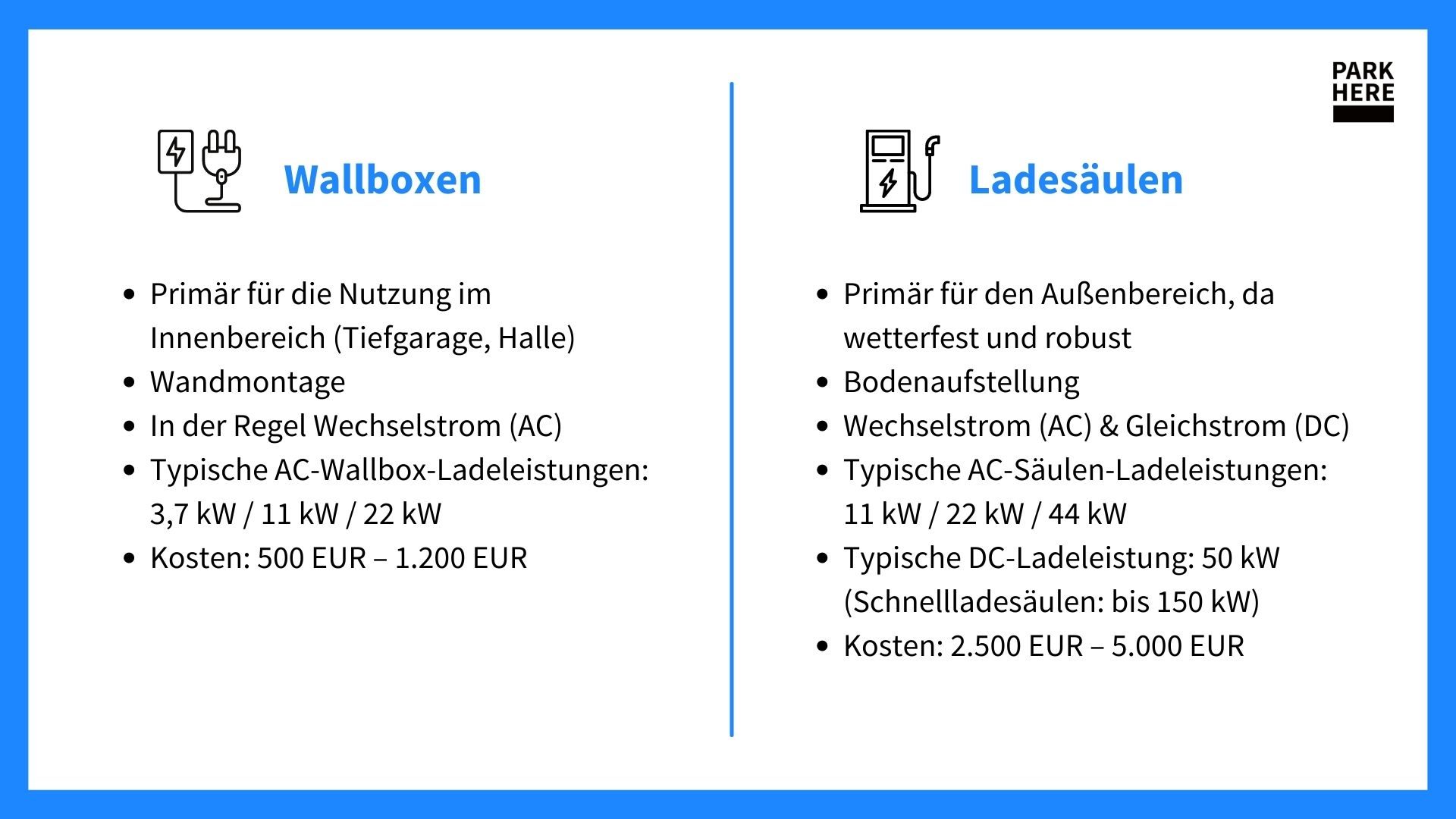Even though the proportion of purely electric cars in total traffic volume in Germany has so far only been about one percent, electromobility is spreading unstoppably. Traffic experts assume that in 2030 almost every fourth vehicle on Germany's roads (24.4%) will have an electric drive. For companies with their own (or rented) parking spaces, this should be reason enough to consider the establishment of a charging infrastructure with charging stations, at least. With the help of the following 4 questions, company representatives can then determine which approach makes sense for them.
Download our free white paper Smart Parking for Companies now and learn everything important about the topic.

Further arguments for setting up a company-owned charging infrastructure are:
As soon as the charging current has to be paid for, the providing company also incurs sales tax. However, the following applies: If the electricity price for the employees is lower than the electricity purchase price plus the ancillary costs – i.e. if the company offers the electricity at a reduced price – the minimum assessment base according to § 10 Para. 4 No. 1 UstG applies. The situation is different if the employees have to pay at least the local electricity price: Then the company generates taxable sales in any case. If the electricity also comes from a company's own PV system, there is most likely also electricity tax, because then the company is deemed to be an electricity producer according to EEG.

The question of what type of charging stations for companies are the right choice can therefore be answered quite simply with the structural conditions. Are the parking spaces located in the uncovered outdoor area? Then only park columns are an option. Wall boxes are also an option for underground parking spaces.
The question remains about the charging station output: How high should it be? If only private employee vehicles are charging electricity at the charging stations, which do not have to be moved during working hours, then alternating current charging stations are sufficient. However, if fleet vehicles are charged that are in use during the day (for example as delivery vehicles), then charging should take place more quickly. You then have to think about powerful direct current charging stations.
Once the number of potential users has been determined, it is time to break it down. Normally, a 1:1 key is recommended for the planning of charging options (= one charging option per vehicle). Since keeping track of charging times and organizing parking times is cumbersome, one has to assume that parked e-vehicles will not be moved during working hours. However, this only applies if parking at charging stations in the company is not digitally controlled. With an app-supported parking space management solution such as the ParkHere system, however, it is no problem to perfectly organize parking or charging time allocations. This makes it possible to realize a 3:1 key: 3 vehicles can then be charged per charging option in the course of a working day. This significantly reduces investment costs, as fewer columns have to be purchased.
Would you like to learn more about electromobility and smart parking? In our Download Center there are further information, success stories and tips. Put it in first gear and come by!

Download our free white paper Smart Parking for Companies now and learn everything important about the topic.

Question 1:
What are the Reasons for Setting up Charging Stations at the Company Location?
The question of what advantages charging stations for electric cars in companies have at all is certainly the most important question of all – after all, the investment costs amount to several thousand euros. How much money exactly has to be planned per charging station cannot be determined across the board, because various factors play a role in this. Among other things, it depends on what type of charging stations in the company are to be set up (wall boxes or charging stations) and what output they should have. The price range extends from 500 euros/piece for simple wall boxes to 5,000 euros for premium charging stations. However, the public sector grants high subsidies. And that is already the first argument in favor of charging stations for companies:Charging Stations for Companies Have been Publicly Funded since 2019.
Via the nationwide KfW funding No. 441 for example, companies can receive up to 900 euros for each charging point that they set up in their (non-public) company parking lot. There are also funding programs at the state level: NRW, for example, promotes charging stations for electric cars in companies with up to 1,500 euros. The funding is available even if a company does not have its own e-fleet vehicles and only purchases the charging stations for the private electric vehicles of its employees.Further arguments for setting up a company-owned charging infrastructure are:
Companies with Charging Stations Present Themselves as Attractive Employers.
If employees in a company not only have the opportunity to park their e-vehicles safely at the workplace, but can also fill up with electricity there, this is a powerful recruiting argument. Charging stations can therefore attract – and retain – talent.The Company Image Benefits.
If a company has parking spaces with an e-vehicle charging infrastructure, this signals to the public on the one hand employee care (since the employees are freed from parking search stress and range anxiety) and on the other hand a sustainable attitude. Conversely, if a company does NOT offer charging options despite the availability of parking spaces, its efforts to achieve a sustainability image will be thwarted.Charging Stations Can be a Source of Income.
If the electricity for the charging stations is generated by the company – for example via photovoltaic systems – it can be sold to the employees and visitors. However, there are a few aspects to consider, see Question 2. But even if the electricity is not sold at a profit (but only resold or even given away), income can be generated with charging stations – namely via parking. After all, parking and charging are two different things, and the provision of a charging infrastructure justifies parking space management in any case.Question 2:
Should the Charging Current be Offered Free of Charge or for a Fee?
This is probably the second most important question that companies have to ask themselves with regard to the establishment of a charging infrastructure. In principle, there are three options for companies to offer charging current:- free of charge,
- reduced or
- subject to a charge without reduction.
As soon as the charging current has to be paid for, the providing company also incurs sales tax. However, the following applies: If the electricity price for the employees is lower than the electricity purchase price plus the ancillary costs – i.e. if the company offers the electricity at a reduced price – the minimum assessment base according to § 10 Para. 4 No. 1 UstG applies. The situation is different if the employees have to pay at least the local electricity price: Then the company generates taxable sales in any case. If the electricity also comes from a company's own PV system, there is most likely also electricity tax, because then the company is deemed to be an electricity producer according to EEG.
Question 3:
Charging Stations or Wall Boxes?
Both charging stations and wall boxes are basically software-controlled fuse boxes with sockets for the standardized type 2 connector of the charging cable. The main difference between them is that charging stations are suitable for installation outdoors – wall boxes are not. Charging stations also usually have a higher charging capacity than wall boxes. However, they are more expensive to purchase. Both types of stations may only be installed by specialist companies, and they must be registered with the responsible electricity supplier.
The question of what type of charging stations for companies are the right choice can therefore be answered quite simply with the structural conditions. Are the parking spaces located in the uncovered outdoor area? Then only park columns are an option. Wall boxes are also an option for underground parking spaces.
The question remains about the charging station output: How high should it be? If only private employee vehicles are charging electricity at the charging stations, which do not have to be moved during working hours, then alternating current charging stations are sufficient. However, if fleet vehicles are charged that are in use during the day (for example as delivery vehicles), then charging should take place more quickly. You then have to think about powerful direct current charging stations.
Question 4:
How many Charging Stations are Needed and how Can They be Used Efficiently?
The answer to the question of the optimal number of charging stations for companies of course depends on the number of electric cars in the workforce. Not only the existing electric vehicles have to be taken into account, but also those that may be added in the future. It is therefore advisable to carry out a needs analysis in advance: How many employees currently use an e-vehicle, how many are planning to switch to e-mobility in the near future? The survey of the workforce is itself a factor influencing demand, because if the employees know that a charging infrastructure is to be set up in the company, they may be more willing to switch.Once the number of potential users has been determined, it is time to break it down. Normally, a 1:1 key is recommended for the planning of charging options (= one charging option per vehicle). Since keeping track of charging times and organizing parking times is cumbersome, one has to assume that parked e-vehicles will not be moved during working hours. However, this only applies if parking at charging stations in the company is not digitally controlled. With an app-supported parking space management solution such as the ParkHere system, however, it is no problem to perfectly organize parking or charging time allocations. This makes it possible to realize a 3:1 key: 3 vehicles can then be charged per charging option in the course of a working day. This significantly reduces investment costs, as fewer columns have to be purchased.
Conclusion
That charging stations for companies with their own parking spaces are a sensible thing is practically beyond question. Thanks to a variety of funding opportunities, the purchase does not have to be too expensive – especially not if a digital parking space management system is implemented at the same time, which on the one hand enables profitable parking space management and on the other hand triples the availability per column. However, companies should consider very carefully whether they charge their employees for the charging current: The potential income is offset by significantly higher investment costs and tax deductions; in addition, the employee retention instrument "free charging" is given out of hand.Would you like to learn more about electromobility and smart parking? In our Download Center there are further information, success stories and tips. Put it in first gear and come by!

